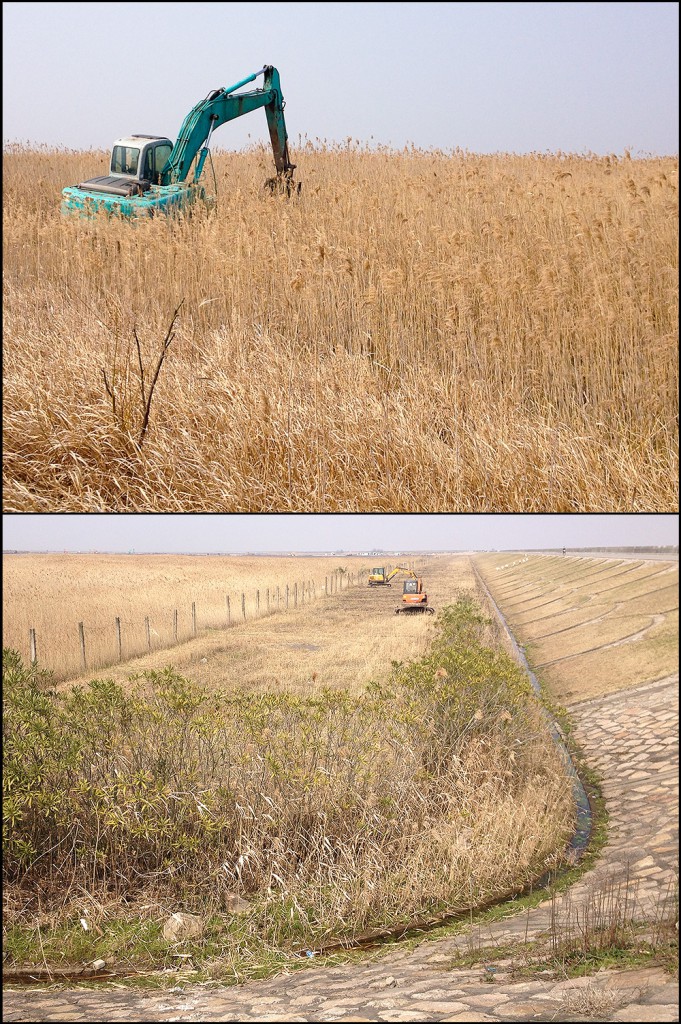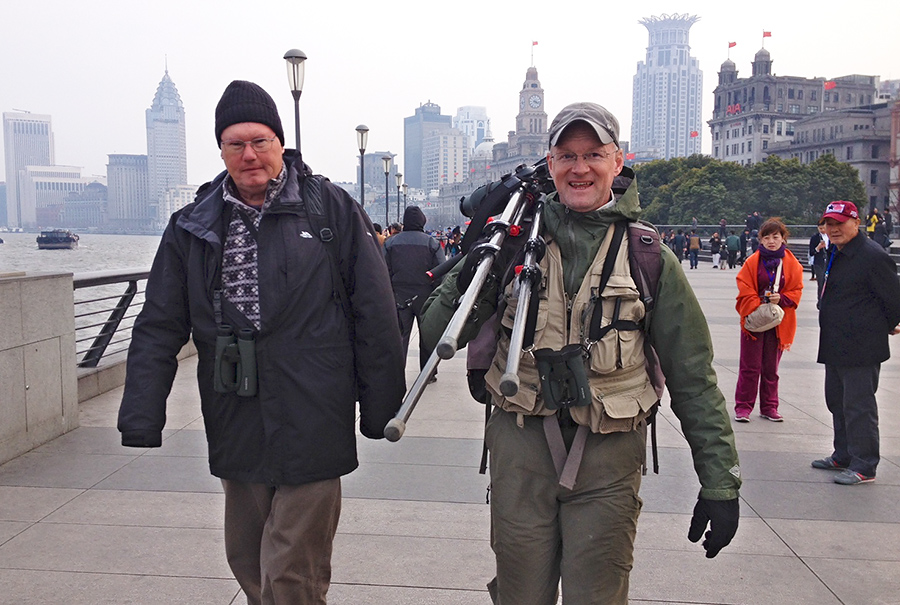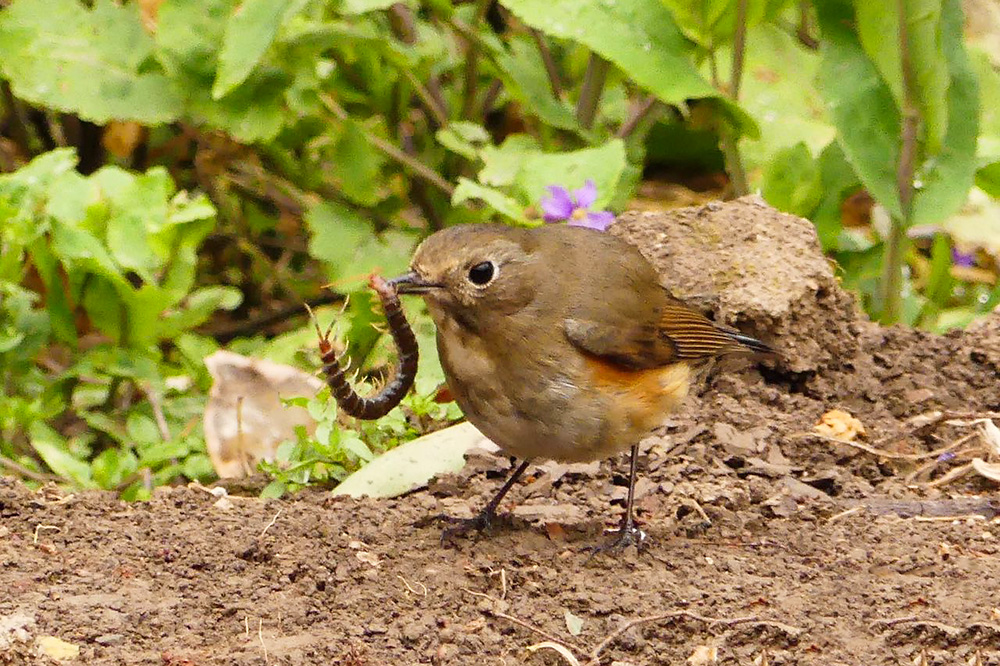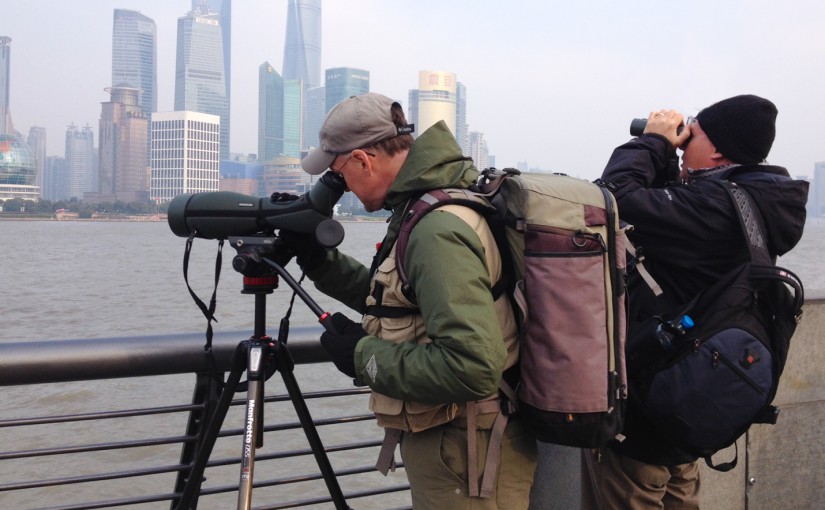by Craig Brelsford
Founder, shanghaibirding.com
It’s spring in Shanghai! The equinox hasn’t arrived yet, but Chinese New Year has passed, and in the parks the flowers are blooming. In recent days in Shanghai, Elaine Du and I have noted Black-necked Grebe in breeding plumage, seen Greater Scaup lingering at Dishui Lake, and found Red-throated Thrush amid lawn-loving Dusky Thrush at Century Park.
We reached all our destinations on foot or by subway, with two short taxi rides thrown in. Development continues in Shanghai, and it’s a double-edged sword; the ever-more efficient transportation system allows one to bird Cape Nanhui cheaply, but development is also threatening Cape Nanhui, as more and more reed beds fall to the bulldozer and backhoe.
On Mon. 7 March, fresh from our big trip to the Dulong Gorge in Yunnan, Elaine and I did our first birding of the season at Zhongshan Park. We ran into Wāng Jìn Róng (汪进荣), a delightful local man who loves to photograph birds. He never tires of watching the Red-flanked Bluetail and Common Kingfisher that use the wooded area around the little central pond. When we heard the thin calls of Yellow-bellied Tit and discovered them on a bare branch across from where we were standing, Mr. Wang said we had brought him good luck. We heard Eurasian Siskin and Chinese Grosbeak in the trees above. Japanese Tit are singing, and Chinese Blackbird have begun to breed. Pale Thrush are a reminder of winter. Mr. Wang proudly showed us the Indochinese Yuhina he photographed recently at Yangpu Park, and he told us that he has seen Silver-throated Bushtit at Zhongshan Park.
On Fri. 11 March, Elaine and I made Elaine’s first visit ever and my first since Christmas Day 2011 to Shanghai Botanical Garden. We noted 23 species. 2 Collared Finchbill raised the old question of whether they are really wild, and 2 Yellow-browed Warbler may be a sign that the spring migration is beginning or may merely signify that Yellow-browed remains in Shanghai throughout the winter; Shanghai lying right at the northern edge of this species’ winter range.
We searched in vain for White’s Thrush, and we found only 1 Grey-backed Thrush. Among our 9 Pale Thrush was one completely tamed by the photographers, whose latest innovation is to spear mealworms on a thin, stiff wire and induce the Daurian Redstart to hover to reach them. The redstart was uninjured by this tactic, which is an ethical step up from fastening mealworms with tiny, ingestible nails (as I have previously found Shanghai-area photographers doing). The photographers were chasing the Pale Thrush off, but so hooked was the thrush on the free protein that it refused to go away and made occasional dives at the baited wire. Elsewhere, we heard in this most urban of settings the same tseep, tseep contact call that Pale Thrush make in the much wilder country near Elaine’s hometown in Heilongjiang—Pale Thrush breeding ground.
A search for buntings in the nursery area turned up 4 Black-faced Bunting, and an old memory of finding small waders floating on garbage in the river was revived when we saw 5 Common Snipe on Zhāngjiātáng Hé (张家塘河). Just as four and a half years ago, these poor snipe were on mats formed by garbage that coalesces in the stagnant water. The snipe were only roosting there, of course, and presumably at dusk they jump onto the nearby muddy ground of the nursery to feed; in any case, the canal, completely walled in, offers zero mud on which to forage.

Shanghai Botanical Garden Gate 4 lies 700 m from Shilong Road Station, Metro Line 3. It is the first place I ever birded in China, two weeks after my arrival in Shanghai in October 2007. I relived with Elaine the thrilling moment when I beheld White’s Thrush for the first time; a moment that at that time and at my level of experience with Asian birds was just as breathtaking as finding Rufous-breasted Bush Robin last month in Dulong Gorge.
On Sat. 12 March, Elaine, Michael Grunwell, and I found 40 species at Cape Nanhui and Huangpu Park on the Bund. We covered Nanhui and the Bund on foot and walked about 16 km (10 mi.). At Nanhui we met a worker in a digging machine carving ditches through which to drain large areas of reed bed, which he said when dry will be leveled and replanted with trees. The operation was well under way; water was running through the newly cut channels as fast as a mountain stream.
This distressing transformation is going to spell disaster for the Reed Parrotbill that are still fairly common at Cape Nanhui. It will mean the end of habitat much relied on by Pallas’s Reed Bunting and Chinese Penduline Tit for winter habitat, it will take away breeding habitat for Oriental Reed Warbler, and it will add to the troubles faced by Oriental Stork and Black-faced Spoonbill, already under pressure at Nanhui.

I have to wonder, when these huge transformative schemes are discussed in the corridors of power, are environmental experts even present? Have the planners even heard of Reed Parrotbill? Has anyone ever shown them a picture of Black-faced Spoonbill?
The only good news is that the artificial forests that will replace the historical reed-bed habitat will attract migrating passerines, which could use some help as they make their way up and down the Chinese coast. But that was cold comfort for us. “Pale Thrush will tseep where Reed Parrotbill used to chirr,” I sighed to my companions.
The bird scene at Nanhui was more wintry than spring-y, but we found tschutschensis Eastern Yellow Wagtail assuming breeding plumage and at Dishui Lake found Black-necked Grebe in breeding plumage. Dishui also yielded 7 Greater Scaup as well as Falcated Duck and Tufted Duck. Pied Avocet, Common Snipe, Dunlin, and Common Greenshank winter in the area; we saw no early evidence of spring migration among shorebirds.

Continuing our theme of birding-by-subway, we moved our party via Metro Line 16 and Line 2 to the Bund. There, Michael carefully picked through the ca. 150 Vega Gull (Larus vegae vegae/mongolicus) in a fruitless search for a rarity such as Kamchatka Gull or even Heuglin’s. Black-headed Gull were there.
The problem with gulling at Shanghai’s most famous landmark is that one is simultaneously examining some of the trickiest birds known to birding and dealing with dozens of onlookers interested in the laowai with the big lens. However, this most international of meeting points also sends interesting people your way, birders such as Shelley Rutkin, who noticed our activities and introduced herself. It’s a grand place to make friends, there on the Bund with the Pudong skyline as your backdrop.
Shelley told us that a birder had reported Slaty-backed Gull on the Huangpu River. This birder was near Shangri-La Hotel on the Pudong side. I have yet to bird Huangpu River from the Pudong side and will be interested to hear how others fare there. Shelley also sent us an interesting image of Red-flanked Bluetail attacking a centipede. Thanks, Shelley!

On Tues. 15 March Elaine and I noted the Red-throated Thrush at Century Park. Elaine spotted the thrush at sunset at the spacious lawn (31.216194, 121.548472). The thrush was in the company of 60 Dusky Thrush and 1 Naumann’s Thrush that had descended onto the lawn to feed. Turdus ruficollis is scarce in Shanghai; Elaine and I note it two or three times each spring and autumn.
The thrushes were among 28 species we noted on our first trip to Century Park this year. Except for the Red-throated Thrush, the lineup was typical of the place and season. We noted a personal record high of 54 Pale Thrush, and large numbers of White-cheeked Starling and Red-billed Starling were assembling in trees around the very effective Bird Island in the middle of the park. Chinese Blackbird, Chinese Grosbeak, and Japanese Tit were singing.
When we arrived at 15:00, the park was crowded with photographers taking pictures of the cherry trees in bloom. Elaine and I know the park well and retreated to the quietest corners, where we found shy species such as Yellow-throated Bunting and Grey-backed Thrush. As the sun was setting, Elaine found White’s Thrush on the edge of the spacious lawn, which 90 minutes before had been full of people and which now, with all the visitors gone, was turning into a thrush feeding ground.
Featured image: With the Pudong skyscrapers as their backdrop, Craig Brelsford (L) and Michael Grunwell scan the Huangpu River for gulls. Bund, Shanghai, 12 March. (Elaine Du)


